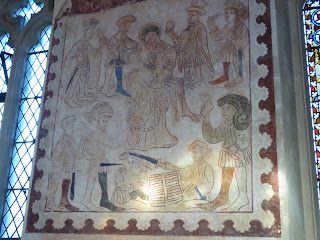Tuesday, 24 January 2017
Tuesday (2)
More about the wall paintings in Saint Lawrence's Church, Broughton, Buckinghamshire.
The painting above is over the North doorway, and is a 'Doom' or a painting of the 'Last Judgement'. It is rather like, but much smaller than, our Suffolk 'Wenhaston Doom', but has a good many similarities like the Jaws of Hell at the bottom right of the picture.
Above picture shows Saint George destroying the dragon.
Above is the one that fascinates me. According to the booklet on the subject it shows 'a collection of blacksmith's tools and products' and I couldn't better that as a description, but it does leave a good many questions unanswered. Why should an English Church be decorated with a collection of a blacksmiths tools and products ? Very odd.
The above picture shows the dead Christ in the arms of his mother, surrounded by nine men, including two who are playing backgammon, both with drawn knives. The other men are holding parts of the body of the dead Christ. All the standing men are very similar. It has been suggested the pictures are a warning against the worship of religious relics, and also a warning against swearing oaths on body parts..........all very odd, as indeed are all their legs, which all end at the knees, and are equipped with very large feet. The whole picture is very odd, and probably full of hidden meaning???
Like a great many of our smaller and more remote churches, Saint Lawrence's should be better known than it is.
Good Night All.
Subscribe to:
Post Comments (Atom)




7 comments:
It would seem that the outfits in the last picture are possibly medieval (Tudor period) which may explain the odd feet, in that era they may have worn pointed shoes/boots? Pure guesswork though.
Probably the two men were gambling for the parts of the body?
Incredible work and very interesting.
Hello Mags. Thanks for the comment. All the pictures are supposed to date from 1470-1480, so your 'guess' is pretty accurate - just pre Tudor. The only bit of gambling I can remember in the Gospels are the Roman soldiers around the cross 'casting lots' for the Lord's cloak, which was 'woven through-out', and I suppose playing backgammon could equate to 'casting lots'; so I think that's a couple of good bits of 'pure guesswork'. Well done Mag. Thank you.
It's many years ago but I'm sure I saw a very moving statue of Mary holding Christ's body on her lap in St Peter's in Rome. Was it called La Pietra?
Hello Pat. What a good memory you have. The statue you remember was made in 1488/9 by Michelangelo, and is called La Pieta.
Just a wild surmise Mike but consider the five gentlemen with bare (or at least uncoloured) left feet; could this imply they were Mithraists, perhaps? I understood that current military practice of marching off by the left foot was in celebration of the youthful soldier god, Mithras.
Hello Crowbard. I know that the Mithraic cult was (generally speaking) the roman soldiers' God, and you may have a point there, but perhaps we should remember that when this wall painting was done the roman soldiers had departed these shores for just over a thousand years. Have you noticed, by the way the peculiar headgear (all different these chaps are wearing? The more I look at this painting the more peculiar the whole thing seems. As I said, full of hidden meaning, I think.
As you say Mike, but a depiction of the recently crucified Christ showing Roman soldiers in such attire suggests they were not 'main-stream' Roman culture. Probably the cult arrived some decades before dedicated temples were built, possibly with the arrival in Judaea of a small cohort of replacement legionaries from the Crimea.
The locations of the cult of Mithras in the earliest phase c. 80-120 AD are attested by Mithraea (temples to Mithras) datable from pottery at:-
1. Nida/Heddernheim III (Germania Sup.)
2. Mogontiacum (Germania Sup.)
3. Pons Aeni (Noricum)
4. Caesarea Judaea: Mithraeum , a temple to Mithras was located at Caesarea Maritima, Israel. Constructed originally for grain storage, and built in the 1st century A.D., as a coin of Nero beneath the floor indicates. (Nerō Claudius Caesar Augustus Germanicus; 15 December 37 AD – 9 June 68 AD) was Roman Emperor from 54 to 68) Work on the mithraic ceramics found suggested that the Mithraeum could be late first/early second century
Datable inscribed dedications:
• Nida/Heddernheim I (Germania Sup.) (CIMRM 1091/2, 1098)
• Carnuntum III (Pannonia Sup.) (CIMRM 1718)
• Novae (Moesia Inf.) (CIMRM 2268-2269)14
• Oescus(Moesia Inf.)(CIMRM 2250)
• Rome(CIMRM 362, 593-594)
Datable literary reference:
• Rome (Statius, Thebaid, 1.719-20)
The kerch plaques:
• Five small terracotta plaques of a figure holding a knife over a bull have been excavated near Kerch in the Crimea. Two have been included in the CIMRM as CIMRM 11 and CIMRM 12. The bull-slaying figure wears a Phrygian cap, but is otherwise unlike standard depictions of the tauroctony.15
• There are differences of opinion over the date. Beskow, who believes that the cult of Mithras originated here and diffused from here, dates them to the second half of the 1st century BC,16, Clauss in Gordon's translation dates them to 50 BC,17 and Beck dates them to between 50 BC-50 AD.18
So it is possible that the Roman soldiers present at Christ’s crucifixion (estimated by the majority of modern scholars to the date April 7, 30 AD. Another popular date is Friday, April 3, 33 AD) were aware of Mithraism if not followers of the cult.
Post a Comment